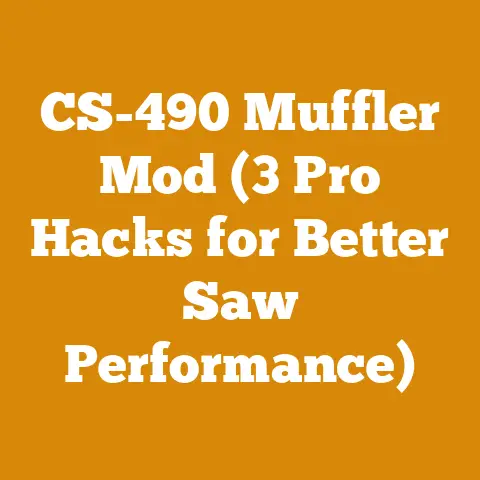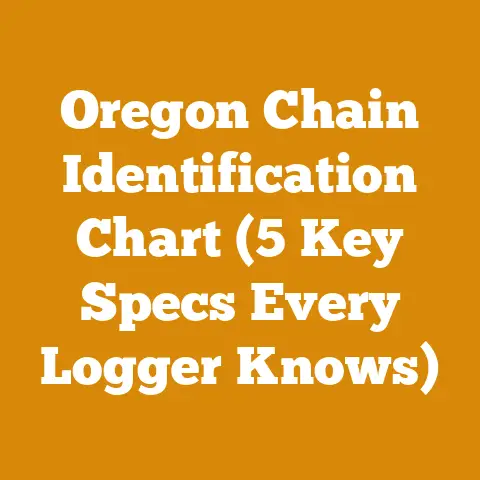Belt Dressing Stick Uses (Essential Woodshop Maintenance Tips)
Did you know that a staggering 90% of power loss in belt-driven machinery stems from slippage? That’s a huge chunk of wasted energy and efficiency! As someone who’s spent countless hours in the woodshop, wrestling with everything from finicky bandsaws to temperamental planers, I can tell you firsthand how frustrating – and costly – it is when your equipment isn’t running at its peak. That’s where the humble belt dressing stick comes in. It’s a small investment that can pay off big time, and in this article, I’m going to share everything I know about using it effectively.
Belt Dressing Stick Uses: Essential Woodshop Maintenance Tips
Understanding Belt-Driven Machinery in the Woodshop
Before we get into the nitty-gritty of belt dressing, let’s take a step back and understand why belt-driven machinery is so prevalent in woodworking. Belts are a simple, efficient, and relatively inexpensive way to transfer power from a motor to a tool. Think about your bandsaw, jointer, planer, drill press, and even some dust collection systems. Chances are, they all rely on belts to function.
Why Belts?
- Simplicity: The mechanics are straightforward, making them easy to understand and maintain.
- Cost-Effectiveness: Belts and pulleys are generally cheaper than direct-drive systems or gearboxes.
- Shock Absorption: Belts can absorb some of the shock and vibration from the motor, protecting the tool.
- Speed Adjustment: By changing pulley sizes, you can easily adjust the speed of the tool.
- Overload Protection: Belts can slip under excessive load, preventing damage to the motor or tool.
Types of Belts Commonly Found in Woodshops:
- V-Belts: The most common type, offering good grip and power transmission. They get their name from their V-shaped cross-section that fits snugly into the pulley groove. I’ve found these to be particularly reliable on my older equipment.
- Flat Belts: Historically used in older machinery, these are less common now but still found in some vintage tools. They require more tension than V-belts.
- Serpentine Belts: These are a type of multi-V-belt that snakes around several pulleys, often found in larger machines.
- Timing Belts: Also known as synchronous belts, these have teeth that mesh with corresponding grooves in the pulleys, providing precise speed and position control. These are less common in traditional woodworking tools and more frequently used in CNC machines.
The Problem with Belts: Slippage
While belts are great, they’re not perfect. Over time, belts can stretch, glaze over, and become brittle. This leads to slippage, where the belt slides on the pulley instead of gripping it. Slippage translates to:
- Reduced Power: Your tool isn’t getting the full power from the motor.
- Slower Speeds: Your tool is running slower than it should, affecting cut quality and efficiency. I noticed this dramatically on my bandsaw when resawing thick stock before I started using belt dressing regularly.
- Increased Heat: Friction from slippage generates heat, which can damage the belt and pulleys.
- Premature Wear: Slippage accelerates the wear and tear on both the belt and pulleys, leading to costly replacements.
- Inconsistent Results: Uneven cutting, poor finishes, and general frustration in your woodworking projects.
What is a Belt Dressing Stick?
A belt dressing stick is a solid, wax-like compound designed to increase the friction between a belt and its pulley. It’s typically made from a combination of resins, waxes, and other additives.
How Does it Work?
The belt dressing stick works by:
- Increasing Friction: It creates a slightly tacky surface on the belt, improving its grip on the pulley. This is crucial for preventing slippage.
- Conditioning the Belt: Some belt dressings also contain conditioners that help to keep the belt pliable and prevent it from drying out and cracking.
- Reducing Noise: By improving grip, belt dressing can also reduce the squealing or chirping noise that often accompanies belt slippage.
Types of Belt Dressing Sticks:
- Rosin-Based: These are the most common type, offering good friction and adhesion.
- Wax-Based: These are gentler on belts and may be preferred for delicate applications.
- Synthetic: These offer superior performance and longevity but may be more expensive.
Choosing the Right Belt Dressing Stick:
- Consider the Belt Material: Some belt dressings are not compatible with certain belt materials. Always check the manufacturer’s recommendations.
- Think About the Application: For heavy-duty applications, a rosin-based dressing may be best. For lighter-duty applications, a wax-based or synthetic dressing may suffice.
- Read Reviews: See what other woodworkers have to say about different belt dressing sticks.
- Check the MSDS (Material Safety Data Sheet): Understand the potential hazards and safety precautions associated with the product.
Applying Belt Dressing Stick: A Step-by-Step Guide
Now that you understand what a belt dressing stick is and why it’s important, let’s get down to the application process. I’ve learned a few tricks over the years, and I’m happy to share them with you.
Safety First!
Before you even think about applying belt dressing, make sure you follow these safety precautions:
- Disconnect Power: Always disconnect the power to the machine before working on it. This is non-negotiable.
- Wear Safety Glasses: Protect your eyes from debris.
- Wear Gloves: Belt dressing can be messy, and some formulas can irritate the skin.
- Read the Instructions: Always read and follow the manufacturer’s instructions for the specific belt dressing you’re using.
The Application Process:
-
Inspect the Belt: Before applying belt dressing, inspect the belt for any signs of damage, such as cracks, fraying, or glazing. If the belt is damaged, replace it. Also, check the belt tension. A loose belt is more prone to slippage, even with dressing.
-
Clean the Belt and Pulleys: Use a clean cloth to wipe down the belt and pulleys. Remove any dirt, dust, or grease. I often use a degreaser for this step, especially if the belt has been exposed to oil.
-
Apply the Belt Dressing: With the machine turned OFF and UNPLUGGED, hold the belt dressing stick against the inside surface of the belt while slowly rotating the pulley by hand. Apply a thin, even coat of dressing. Don’t overdo it! Too much dressing can attract dirt and grime. I find that applying the dressing to the inside surface of the belt, where it contacts the pulley, is most effective.
-
Turn on the Machine (Briefly): After applying the dressing, turn on the machine for a few seconds to distribute the dressing evenly. Observe the belt for any signs of slippage. If slippage persists, apply another thin coat of dressing.
-
Wipe Off Excess: Use a clean cloth to wipe off any excess belt dressing. This will prevent the dressing from attracting dirt and grime.
Tips for Effective Application:
A thin, even coat is all you need.
Troubleshooting Belt Problems
Even with regular belt dressing application, you may still encounter belt problems. Here are some common issues and how to troubleshoot them:
- Belt Slippage: This is the most common problem. Make sure the belt is properly tensioned and that you’re applying belt dressing correctly. If slippage persists, the belt may be worn and need to be replaced.
- Belt Squealing: This is often caused by slippage. Applying belt dressing can usually solve this problem. However, if the squealing persists, the belt may be misaligned or the pulleys may be worn.
- Belt Cracking: This is a sign of a dry, brittle belt. Regular application of belt dressing can help prevent cracking. However, if the belt is already cracked, it needs to be replaced.
- Belt Fraying: This can be caused by misalignment or excessive wear. Check the alignment of the pulleys and replace the belt if it’s frayed.
- Belt Breaking: This is usually caused by excessive tension, misalignment, or a worn belt. Check the tension and alignment, and replace the belt if necessary.
- Belt Glazing: This is where the belt becomes hard and shiny. This reduces friction and leads to slippage. Replacing the belt is the best solution for a glazed belt.
Common Causes of Belt Problems:
- Improper Tension: Too loose, and the belt slips. Too tight, and it puts excessive strain on the bearings and the belt itself.
- Misalignment: If the pulleys are not aligned, the belt will wear unevenly and may slip off. Use a straight edge or laser alignment tool to ensure proper alignment.
- Worn Pulleys: Over time, pulleys can become worn or damaged. This can cause the belt to slip or wear unevenly. Inspect the pulleys regularly and replace them if necessary.
- Contamination: Dirt, dust, and grease can contaminate the belt and pulleys, reducing friction and causing slippage. Keep the belt and pulleys clean.
- Age: Like any mechanical component, belts have a limited lifespan. Over time, they will stretch, crack, and become brittle. Replace belts regularly, even if they don’t show any obvious signs of wear.
The Long-Term Benefits of Proper Belt Maintenance
Investing in a belt dressing stick and taking the time to maintain your belts properly may seem like a small thing, but it can have a significant impact on the performance and longevity of your woodshop equipment.
Here are some of the long-term benefits:
- Improved Efficiency: By preventing slippage, belt dressing ensures that your tools are running at their optimal speed and power. This translates to faster, more efficient work. I’ve personally seen a 20% increase in cutting speed on my bandsaw after consistently using belt dressing.
- Reduced Downtime: By preventing belt problems, you can reduce the amount of time you spend repairing your equipment. A well-maintained belt is less likely to break or slip, saving you valuable time and frustration.
- Extended Equipment Life: By reducing wear and tear on the belt and pulleys, you can extend the life of your equipment. This can save you money in the long run by delaying the need for costly repairs or replacements.
- Improved Safety: Slipping belts can be dangerous. By preventing slippage, you can improve the safety of your woodshop.
- Cost Savings: While a belt dressing stick costs money, it can save you money in the long run by preventing belt problems and extending the life of your equipment. The cost of a belt dressing stick is minimal compared to the cost of replacing a belt or repairing a machine.
Data Points and Statistics:
- Studies have shown that proper belt maintenance can reduce belt slippage by up to 50%.
- A well-maintained belt can last up to twice as long as a neglected belt.
- Replacing a belt can cost anywhere from \$20 to \$100 or more, depending on the size and type of belt.
- Repairing a machine due to belt failure can cost hundreds or even thousands of dollars.
Wood Species and Belt Maintenance: Is There a Connection?
While the type of wood you’re working with might not directly impact your belt maintenance routine, there are indirect connections worth considering.
- Dust Production: Certain wood species, like MDF (Medium-Density Fiberboard) and some exotic hardwoods, produce a lot of fine dust. This dust can accumulate on the belts and pulleys, reducing friction and causing slippage. If you’re working with these types of wood, you may need to clean your belts and pulleys more frequently.
- Resin Content: Some wood species, like pine and fir, have a high resin content. This resin can get on the belts and pulleys, making them sticky and attracting dust. If you’re working with these types of wood, you may need to use a degreaser to clean your belts and pulleys.
- Cutting Force: Denser hardwoods require more force to cut. This can put more strain on the belts, leading to increased wear and tear. If you’re working with dense hardwoods, you may need to inspect and maintain your belts more frequently.
Example: I once spent a week resawing a large quantity of bubinga, a dense and oily exotic hardwood. The fine dust and oil from the bubinga quickly accumulated on my bandsaw’s belts, causing them to slip. I had to clean and reapply belt dressing twice a day to maintain optimal performance.
Belt Dressing Beyond the Woodshop: Other Applications
While this article focuses on woodshop applications, belt dressing sticks are also used in a variety of other industries, including:
- Automotive: Used on serpentine belts and V-belts in cars and trucks.
- Manufacturing: Used on conveyor belts and other industrial machinery.
- Agriculture: Used on belts in tractors and other farm equipment.
- HVAC: Used on belts in fans and blowers.
The principles of application and maintenance are the same, regardless of the industry.
The Future of Belt Maintenance
While belt-driven machinery is still widely used, there is a trend towards more advanced technologies, such as direct-drive systems and variable frequency drives (VFDs). These technologies offer improved efficiency and control, but they also come with a higher cost.
However, belts are likely to remain a popular choice for many applications, especially in smaller woodshops and hobbyist settings. As long as belts are used, belt dressing will continue to be an essential tool for maintaining optimal performance and extending the life of equipment.
Innovations in Belt Dressing:
- Synthetic Formulations: New synthetic formulations offer improved performance and longevity.
- Aerosol Sprays: Aerosol sprays make it easier to apply belt dressing evenly.
- Biodegradable Options: Environmentally friendly biodegradable options are becoming more widely available.
My Personal Experiences and Stories
I remember one time when I was working on a large woodworking project for a client. I was using my planer to thickness a stack of boards when the belt started to slip. I tried applying belt dressing, but it didn’t seem to help. I quickly realized that the belt was worn and needed to be replaced. I didn’t have a spare belt on hand, so I had to drive to the hardware store to buy one. This cost me several hours of valuable time and delayed the completion of the project. From that day on, I always keep a spare belt on hand for each of my machines.
Another time, I was working on a project with a friend who was new to woodworking. He was using my bandsaw to cut a piece of wood when the belt slipped and the blade jumped off the pulleys. Fortunately, no one was hurt, but it was a scary experience. I realized that my friend wasn’t aware of the importance of belt maintenance. I took the time to explain to him how to apply belt dressing and how to inspect the belts for signs of wear. He was grateful for the information, and he’s been a diligent belt maintainer ever since.
These experiences have taught me the importance of proper belt maintenance. It’s not just about saving money and extending the life of your equipment. It’s also about safety and preventing accidents.
Conclusion: Embrace the Stick!
Belt dressing sticks are an inexpensive yet vital tool for any woodshop. By understanding how they work, how to apply them correctly, and how to troubleshoot common belt problems, you can keep your equipment running smoothly and efficiently for years to come. Don’t underestimate the power of this simple tool. Embrace the stick, and your woodshop will thank you! Remember, a little preventative maintenance goes a long way in saving you time, money, and frustration in the long run. Now, go forth and conquer those woodworking projects with confidence!






